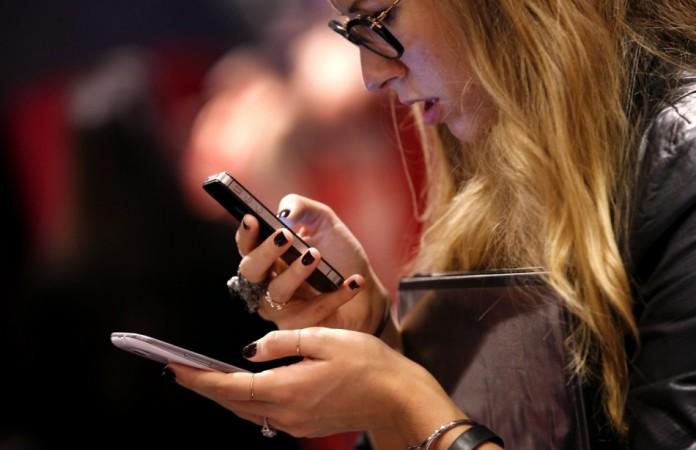
On Monday (21 April), Taiwanese company in its bid to focus on mid-range Indian smartphone market, launched HTC Desire 816 along with flagship HTC One M8 and entry-level Desire 210 in to the subcontinent.
On the same day, rival Sony also launched a similar category phone Xperia M2. Both the new smartphone will now compete with popular devices Samsung Galaxy Grand 2 and the feature-rich Motorola Moto X.
Prospective consumers who are looking for an upper mid-range (₹20,000 plus) category MNC branded handsets, can check out these four devices- Samsung Galaxy Grand 2, HTC Desire 816, Motorola Moto X and Sony Xperia M2, which are relatively new to the Indian market.
Here is a brief comparison of Samsung Galaxy Grand 2, HTC Desire 816, Motorola Moto X and Sony Xperia M2:
Design and Design:
Samsung's smartphone flaunts a rectangular design, (less curvy than its predecessor) and its plastic based rear-side is disguised under the faux-leather stitching with chrome finish around the bezel.
Galaxy Grand 2 features a 5.25-inch HD (1280x720p) TFT LCD screen with pixel density close to 280 ppi (pixels per inch).
Whereas HTC Desire 816 is biggest of the lot and boasts monster 5.5-inch HD (1280px720) display, but due to its massive screen size, display clarity takes a beating, leaving pixel count at 267 ppi.
Motorola Moto X, on the outlook, boasts one of the unique design languages in the smartphone market; its sloping edge near the corners, the bump in middle and its 4.7-inch body makes up for a perfect combination for one hand usage and also its soft back-cover helps users have a comfortable hold on the phone.
The Motorola phone features energy efficient AMOLED display with pixel density of 329 ppi and also boasts of special water repellant nano-coating inside and outside.
Sony's new phone Xperia M2 borrows the 'Omni-balance' design from the flagship Xperia Z2, sans the water-and-dust resistant body. But, compared to rivals on the top, this 4.8-inch Sony phone priced closed to ₹22,000 loses some points for its sub-par qHD (540x960p) resolution screen with pixel density of 229 ppi.
Processor, RAM and Storage:
Galaxy Grand 2 houses the 1.2GHz Qualcomm Snapdragon 400 series quad-core CPU. It is aptly backed by 1.5GB RAM and 8GB inbuilt memory with options of expanding up to 64GB via microSD card.
On the other hand, HTC Desire 816 too houses same 1.5GB RAM and 8GB inbuilt memory and goes a step ahead with faster 1.6GHz Snapdragon 400 series processor. It also offers huge 128GB storage expandable option.
Whereas the Moto X packs a 1.7GHz dual-core Qualcomm Snapdragon S4 Pro CPU. Many perceive that more the number of cores, the better the performance in the smartphones. Well, this Motorola device dispels this notion by giving rich user-experience with limited resources, thanks to custom Motorola X8 Mobile computing system architecture. The phone also incorporates additional two special utility cores - one natural language processor core and a contextual processor core, which enables the phone to perform some great tricks, no other high-end phones (Samsung Galaxy S5 and Apple iPhone 5S) in the industry can boast off.
Natural language processor powers the 'Touchless Control' feature of Moto X, the phone's mic are always active waiting for user to say the trigger phase 'OK, Google Now' to perform functions like setting an alarm, put reminder on the calendar, ask direction on Google map, play music and many other operations without having to use the finger, he/she can just speak to the phone.
The second special 'Contextual' processor with the help of motion sensors, enables the smartphone be self aware of the environment to display time or any notifications on the screen. The device will know when the user picks the phone out of his pocket, or picks up the phone from the desk near to him and then only the select pixels of the display lights up to show the time or any pending notifications without having to unlock the phone.
[This feature is similar to 'Glance' applications seen on the Windows Phone 8 OS powered Lumia smartphones]
Moto X processor is backed Adreno 320 graphics engine, 2GB RAM and 16GB/32GB (in select markets only). Only downside of this Motorola phone is that it lacks microSD.
Sony Xperia M2, like any other mid-range phone comes with standard 1GB RAM, 8GB inbuilt memory (expandable up to 32GB) powered by 1.2GHz Snapdragon 400 CPU and Adreno 305 graphics engine.
Mobile Operating System:
In this aspect, all the devices stand even as they ship with the same ubiquitous Google Android platform sans running on different OS version.
Among the four devices, Motorola Moto X is only one to come with near stock Android OS and also have the privilege to receive quick OS updates as it is a former affiliate of Google.
[Note: The search engine giant has reportedly sold Motorola Mobility to Lenovo early this year. Moto X (launched in August 2013) is the first smartphone to roll out of Motorola after it got acquired by Google in 2012.]
Galaxy Grand 2 and Sony Xperia M2 come with Android v4.3 Jelly Bean OS with their respective UI, whereas HTC Desire will ship with Sense v5.5 UI, but Android OS version is yet to be ascertained.
Camera:
Samsung Galaxy Grand 2 packs an 8.0-megapixel camera on the rear-side and a 1.9-megapixel HD camera on the front.
Though Galaxy Grand 2 features pretty much same camera specifications seen in its predecessor, the company compensates this issue by loading the new phone with enhanced photo-editing tools like Sound & Shot, Continuous Shot , HDR, and others like Beauty Face, Best Face, Rich Tone (HDR), Panorama, Sports and Night enhance the photography experience.
HTC Desire 816 comes loaded with 13.0-megapixel camera with LED flash, Geo-tagging, touch focus, face detection, simultaneous HD video and image recording, HDR, full HD video recording and on the front, it packs a 5.0-megapixel camera with HD video recording ability.
Moto X, on the other hand, houses a 10.0-megapixel CLEAR PIXEL (RGBC) camera, LED flash, Full HD 1080p video recording ability and a 2.0-megapixel front camera with full HD 1080p video recording ability.
[Note: Motorola phone also boasts of 'Quick-Capture' gesture control feature where in, user can launch the camera in a matter of few seconds just by flipping the device twice horizontally]
Sony Xperia M2's 8.0-megapixel camera incorporates the company's proprietary Exmor RS lens with 4X digital zoom, full HD (1080p) video recording, HDR and more. It also houses a VGA camera for video chat.
[Note: higher pixel number in camera does not guarantee good photo, it depends on the type of lens and aperture size, wider the better]
Price:
Samsung Galaxy Grand 2 made its India debut in January with a price-tag of ₹22,999, now it can be purchased for a little over ₹21,000 in some online stores and local brick-and-mortar shops.
Motorola Moto X is only available via Flipkart for ₹23,999 (plastic models) and have to shell out additional ₹2000 for wooden panel (teak and walnut) models.
As of now, HTC Desire 816 and Xperia M2 are priced 23,900 and 21,990 respectively, but they are not yet reached stores.
Word on the street is that the Sony phone is expected to be released on 25 April, whereas HTC device is expected to be made available by this month end or May first week.
(ED:VS)
Key specifications of Samsung Galaxy Grand 2, HTC Desire 816, Motorola Moto X and Sony Xperia M2:
|
Model |
Samsung Galaxy Grand 2 |
HTC Desire 816 |
Motorola Moto X |
Sony Xperia M2 |
|
Display |
5.25-inch HD TFT screen with 1280x720p resolutions |
5.5-inch super LCD 2 HD (720x1280p) screen Pixel density: 267 ppi (pixels per inch) |
4.7-inch AMOLED (RGB) screen with HD 720p display resolutions, Pixel density : 316 ppi |
4.8-inch qHD (540x960p) TFT screen |
|
OS |
Android v4.3 Jelly Bean |
Android (version not revealed ) with Sense v5.5 UI |
Android v4.2.2 Jelly Bean OS (KitKat update released) |
Android v4.3 Jelly Bean |
|
Processor |
1.2GHz Qualcomm Snapdragon 400 series ARM Cortex A7 quad-core processor |
1.6GHz Qualcomm Snapdragon 400 series ARM Cortex A7 CPU |
1.7GHz Qualcomm Snapdragon S4 Pro dual-core CPU with one natural language processor core and a contextual processor core (custom Motorola X8 Mobile computing system architecture) |
1.2GHz Qualcomm Snapdragon quad-core CPU |
|
GPU |
Adreno 305 |
Adreno 305 |
Adreno 320 |
Adreno 305 |
|
RAM |
1.5GB |
1.5GB |
2GB |
1GB |
|
Storage capacity |
8GB, expandable up to 64GB |
8GB, expandable up to 128GB |
16 GB (non-expandable) |
8GB, expandable up to 32GB |
|
Camera |
Main: 8.0-megapixel camera with LED flash, Auto-focus Front: 1.9-megapixel HD camera |
Main: 13.0-megapixel camera with Flash support Front: 5.0-megapixel camera |
Main: 10.0-megapixel CLEAR PIXEL (RGBC) camera, LED flash, Full HD 1080p video recording Front: 2.0-megapixel camera with full HD 1080p video recording ability |
Main: 8.0-megapixel Sony Exmor RS camera, 4X digital zoom, full HD (1080p) video recording, HDR Front: 0.3-megapixel (VGA) camera |
|
Battery |
2,600 mAh |
2,600 mAh |
2200 mAh, Power back-up close to 24 hours |
2300 mAh; Talk time: up to 14 hours 14 minutes Standby time: close to 693 hours |
|
Network |
3G |
3G |
3G & 4G-LTE |
3G |
|
Add-ons |
Bluetooth v4.0, Dual-SIM, GPS+GLONASS, microSD card slot, Wi-Fi (802.11 a/b/g/n), USB v2.0, |
Nano-SIM, Bluetooth v4.0, Wi-Fi (802.11 b/g/n), GPS, micro-USB, microSD card slot |
Water-repellent body coating, Bluetooth v4.0 LE + EDR, USB v2.0, Wi-Fi :802.11 a/b/g/n/ ac (dual band capability), GPRS, EDGE |
Dual-SIM slots, Bluetooth v4.0, NFC, Wi-Fi, USB v2.0 (high-speed), noise suppression feature, a-GPS for navigation, 3D sound and motion gaming, |
|
Dimensions |
146.8 x 75.3 x 8.9 mm |
156.6 x 78.7 x 8 mm |
Height: 129.3 mm Width: 65.3 mm Curve: 5.6-10.4 mm |
139.6 x 71.1 x 8.6 mm |
|
Weight |
163 g |
165 g |
130 g |
148 g |
|
Price (MRP) |
₹22,999 |
₹23,990 |
All color variant made of plastic costs ₹23,999, Wood-panel based smartphones - Teak and Walnut variants costs: ₹25,999 |
₹21,990 |
















